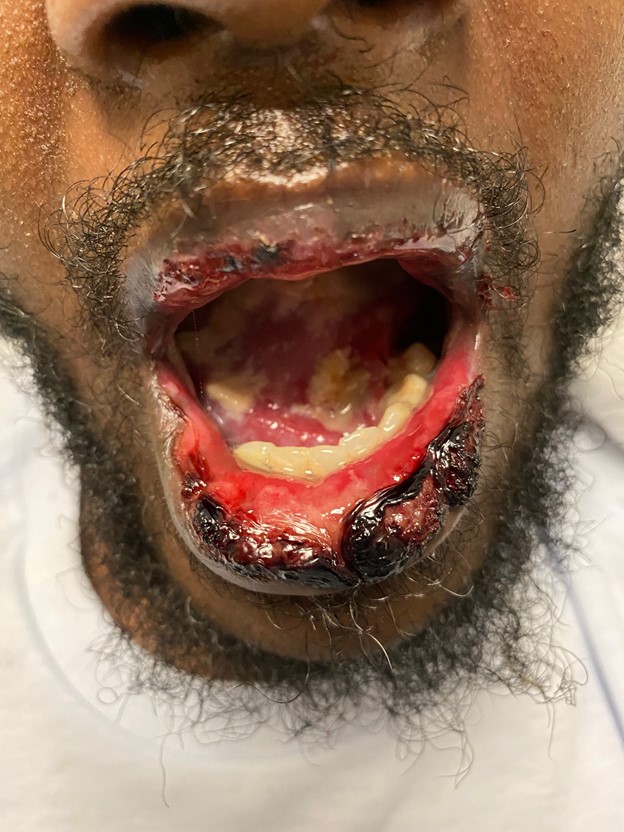RIME!
The rhythm of RIME

By Warren R. Heymann, MD, FAAD
March 2, 2022
Vol. 4, No. 9

Ramien notes that aside from Mycoplasma pneumoniae, other probable triggers include Chlamydophilia (Chlamydia) pneumoniae, influenza B, enterovirus, rhinovirus, human metapneumovirus, and human parainfluenzavirus 2. Possible triggers include varicella-zoster virus, hepatitis A, Epstein-Barr virus, Merkel cell polyomavirus, cytomegalovirus, and HHV-6. These multiple associated infectious triggers prompted Ramien to suggest using the umbrella term "reactive infectious mucocutaneous eruption" (RIME), which would include MIRM. (2) Ryder et al reported a case of a 17-year-old male with RIME secondary to SARS-CoV-2 that was refractory to corticosteroids and improved with cyclosporine. (3)

From my perspective, some of the most perplexing patients with RIME are those with recurrent disease, as I was reminded of yesterday in the emergency room, assessing a young man experiencing his tenth episode in the last 5 years (see photo).
Mazori et al reported the case of an 8-year-old girl with 3 episodes of recurrent RIME. As two of the episodes demonstrated contemporaneous infection with M. pneumoniae and group A streptococcus or influenza B, the authors suggested that respiratory pathogens may synergize to give rise to a mucocutaneous eruption. Her first bout was treated with levofloxacin and intravenous immunoglobulin; the other episodes were treated with azithromycin. In this case, recurrent episodes demonstrated decreased severity compared to the initial episode. (4) (In my limited experience, presumed recurrences may be as severe as prior presentations.)
There is currently no standard of care in managing patients with RIME. Supportive measures, consultation with ophthalmology, urology, and gynecology (as necessary), treating any identifiable infectious trigger (if possible), immunosuppression (steroids, IVIG), and psychological support are warranted. (5) Maredia et al reported 3 cases (aged 9 to 18 years, 2 female, 1 male) with recurrent RIME associated with M. pneumoniae treated successfully with systemic steroids (prednisone or prednisolone). The authors observed that these recurrences were refractory to azithromycin prophylaxis, raising the specter of increasingly reported macrolide-resistant M. pneumoniae. (6)
So many questions need to be answered. Why do some infections trigger RIME in certain hosts? Are there genetic predispositions? What are the molecular events? What is the optimal work-up? Should infectious agents (other than M. pneumoniae) be screened for? What is the optimal treatment regimen? How can recurrences of RIME be prevented?
Point to Remember: RIME (reactive infectious mucocutaneous eruption) incorporates MIRM (Mycoplasma-induced rash and mucositis) and should be distinguished from classical cases of Stevens-Johnson syndrome.
Our expert's viewpoint
Camille Introcaso, MD, FAAD
Associate Professor of Medicine
Cooper Medical School of Rowan University
Case definition is a critical element of epidemiology, the basic science of public health. In order for epidemiologists to make recommendations to improve public health, they go through the following steps: counting cases, identifying risk factors for cases, and developing and testing interventions to decrease the number of cases. Underlying each step is the concept of a case definition, a set of standard criteria used to identify a particular condition. When a case definition is accurate, precise, and uniformly applied, it is the building block for tools of both public health and clinical medicine.
Clinical medicine is often messier than epidemiology. During my time as a medical epidemiologist at the Centers for Disease Control, my colleagues and I sometimes had the luxury of sitting together and prospectively agreeing on the case definition for surveillance systems or outbreak investigations. Clinicians, however, need to make observations, publish case series, and get feedback from colleagues through published literature, presentations, and shared experiences to define and redefine emerging conditions over time. In clinical medicine case counting, risk factor identification, and intervention testing often happen simultaneously, in a necessarily flawed yet estimable effort to help our patients. Because many of our dermatological diseases affect relatively small numbers of patients and have overlapping features and tangled case definitions, real opportunities exist to move our understanding of disease forward.
RIME is an excellent example of this imperfect but elegant process of case definition in clinical medicine. Throughout the 20th century the medical literature had case reports and series of mucosal ulceration associated with respiratory infection (2), but Canavan et al's 2015 article formalized and strengthened that observation, giving us a name and case definition for MIRM — clinical and laboratory evidence of atypical pneumonia, mucositis of 2 or more sites, and either no skin changes or a sparse vesiculobullous and/or targetoid eruption with less than 10% detachment of body surface area. (1) The article also characterized common MIRM variants. (1) This seminal work prompted an explosion of similar observations allowing us to further clarify the spectrum of clinical manifestations of MIRM and to describe interventions.
These observations and refining of the case definition paved the way for Raimen et al to propose the term RIME and clarify that the clinical findings in MIRM can be caused by additional organisms. (2) As Dr. Heymann summarized above, to date the most convincing evidence for RIME associated organisms beyond Mycoplasma pneumonia are also causes of respiratory infection, including a report of RIME in association with SARS-CoV2. (7) It remains to be seen whether non-respiratory pathogens will emerge as substantial causes of RIME. Although multiple possible mechanisms for the clinical findings of RIME have been proposed, including molecular mimicry between infectious agent proteins and keratinocyte antigens, immune complex deposition, and combinations of medication and infection (2), the pathophysiology is unknown. Using our working case definition of MIRM to identify other similar clinical presentations with different causative organisms might help to elucidate the disease mechanism(s) of RIME.
Recurrent RIME is of particular interest given that we could potentially intervene and prevent additional disease. In a case series of 13 patients with MIRM published in 2021, Liakos et al describe a recurrence rate of 38% with an average follow up time of 30 months. The five patients with recurrences had a total of 14 episodes of MIRM. Compared to their initial episodes, recurrences had fewer mucous membranes involved, fewer skin sites involved, and shorter average hospital stays. (8) The authors note that all patients received systemic treatment with unclear benefit. Perhaps our next steps involve identifying RIME patients and following them prospectively to identify risk factors for recurrence, including demographics, type of infection, and therapies received.
Our collective observations and shared work in the medical literature have brought us to an exciting point in the understanding of RIME. We have an evolving but substantial case definition and are poised to use this common language to take the next steps; identifying risk factors, treatments and even preventions. Dr. Heymann's proposed questions about etiology and management are excellent ones, and with continued work we will answer them together.
Holcomb ZE, Hussain S, Huang JT, Delano S. Reactive Infectious Mucocutaneous Eruption Associated with SARS-CoV-2 Infection. JAMA Dermatol. 2021 May 1;157(5):603-605. doi: 10.1001/jamadermatol.2021.0385. PMID: 33825803
Liakos W, Xu A, Finelt N. Clinical features of recurrent Mycoplasma pneumoniae-induced rash and mucositis. Pediatr Dermatol. 2021 Jan;38(1):154-158. doi: 10.1111/pde.14472. Epub 2020 Nov 28. PMID: 33247484.
Ryder CY, Pedersen EA, Mancuso JB. Reactive infectious mucocutaneous eruption secondary to SARS-CoV-2. JAAD Case Rep. 2021 Dec;18:103-105. doi: 10.1016/j.jdcr.2021.10.007. Epub 2021 Oct 20. PMID: 34692963; PMCID: PMC8527593.
Canavan TN, Mathes EF, Frieden I, Shinkai K. Mycoplasma pneumoniae-induced rash and mucositis as a syndrome distinct from Stevens-Johnson syndrome and erythema multiforme: a systematic review. J Am Acad Dermatol. 2015 Feb;72(2):239-45. doi: 10.1016/j.jaad.2014.06.026. PMID: 25592340.
Ramien ML. Reactive infectious mucocutaneous eruption: Mycoplasma pneumoniae-induced rash and mucositis and other parainfectious eruptions. Clin Exp Dermatol. 2021 Apr;46(3):420-429. doi: 10.1111/ced.14404. Epub 2020 Sep 12. PMID: 32918499.
Mazori DR, Nagarajan S, Glick SA. Recurrent reactive infectious mucocutaneous eruption (RIME): Insights from a child with three episodes. Pediatr Dermatol. 2020 May;37(3):545-547. doi: 10.1111/pde.14142. Epub 2020 Mar 15. PMID: 32172537.
Ramien M, Goldman JL. Pediatric SJS-TEN: Where are we now? F1000Res. 2020 Aug 13;9:F1000 Faculty Rev-982. doi: 10.12688/f1000research.20419.1. PMID: 32850118; PMCID: PMC7431970.
Maredia H, Eseonu A, Grossberg AL, Cohen BA. Recurrent Mycoplasma pneumoniae-associated reactive infectious mucocutaneous eruption responsive to systemic steroids: A case series. JAAD Case Rep. 2021 Mar 16;11:139-143. doi: 10.1016/j.jdcr.2021.03.009. PMID: 33997214; PMCID: PMC8100349.
All content found on Dermatology World Insights and Inquiries, including: text, images, video, audio, or other formats, were created for informational purposes only. The content represents the opinions of the authors and should not be interpreted as the official AAD position on any topic addressed. It is not intended to be a substitute for professional medical advice, diagnosis, or treatment.
DW Insights and Inquiries archive
Explore hundreds of Dermatology World Insights and Inquiries articles by clinical area, specific condition, or medical journal source
posted by dermatica at
March 02, 2022
![]()
![]()

0 Comments:
Post a Comment
Subscribe to Post Comments [Atom]
<< Home